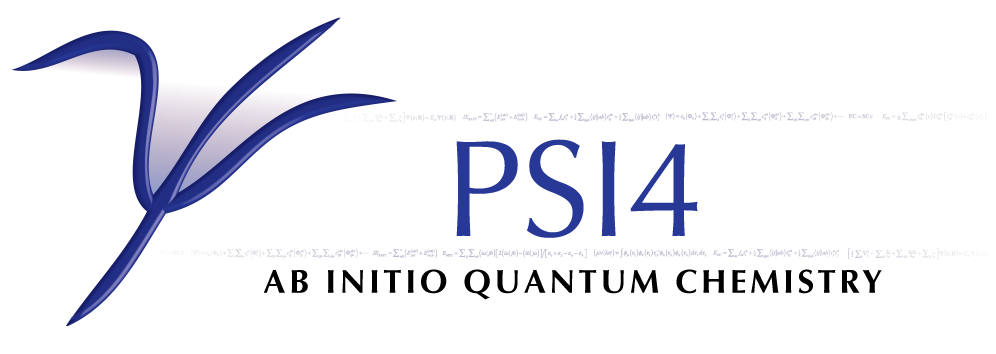
PSIMRCC¶
Performs multireference coupled cluster computations. This theory should be used only by advanced users with a good working knowledge of multireference techniques.
General¶
CC_NUM_THREADS¶
Number of threads
- Type: integer
- Default: 1
CORR_ANSATZ¶
The ansatz to use for MRCC computations
- Type: string
- Possible Values: SR, MK, BW, APBW
- Default: MK
CORR_CCSD_T¶
The type of CCSD(T) computation to perform
- Type: string
- Possible Values: STANDARD, PITTNER
- Default: STANDARD
CORR_CHARGE¶
The molecular charge of the target state
- Type: integer
- Default: 0
CORR_MULTP¶
The multiplicity,
, of the target state. Must be specified if different from the reference
.
- Type: integer
- Default: 1
CORR_REFERENCE¶
Reference wavefunction type used in MRCC computations
- Type: string
- Possible Values: RHF, ROHF, TCSCF, MCSCF, GENERAL
- Default: GENERAL
CORR_WFN¶
The type of correlated wavefunction
- Type: string
- Possible Values: PT2, CCSD, MP2-CCSD, CCSD_T
- Default: CCSD
COUPLING¶
The order of coupling terms to include in MRCCSDT computations
- Type: string
- Possible Values: NONE, LINEAR, QUADRATIC, CUBIC
- Default: CUBIC
COUPLING_TERMS¶
Do include the terms that couple the reference determinants?
- Type: boolean
- Default: true
DAMPING_PERCENTAGE¶
The amount (percentage) of damping to apply to the amplitude updates. 0 will result in a full update, 100 will completely stall the update. A value around 20 (which corresponds to 20% of the amplitudes from the previous iteration being mixed into the current iteration) can help in cases where oscillatory convergence is observed.
- Type: double
- Default: 0.0
DIAGONALIZE_HEFF¶
Do diagonalize the effective Hamiltonian?
- Type: boolean
- Default: false
DIAGONAL_CCSD_T¶
Do include the diagonal corrections in (T) computations?
- Type: boolean
- Default: true
DIIS_MAX_VECS¶
Maximum number of error vectors stored for DIIS extrapolation
- Type: integer
- Default: 7
DIIS_START¶
The number of DIIS vectors needed before extrapolation is performed
- Type: integer
- Default: 2
E_CONVERGENCE¶
Convergence criterion for energy.
- Type: conv double
- Default: 1e-9
FAVG_CCSD_T¶
Do use the averaged Fock matrix over all references in (T) computations?
- Type: boolean
- Default: false
FOLLOW_ROOT¶
Which root of the effective hamiltonian is the target state?
- Type: integer
- Default: 1
FROZEN_DOCC¶
The number of frozen occupied orbitals per irrep
- Type: array
- Default: No Default
FROZEN_UOCC¶
The number of frozen virtual orbitals per irrep
- Type: array
- Default: No Default
HEFF4¶
Do include the fourth-order contributions to the effective Hamiltonian?
- Type: boolean
- Default: true
HEFF_PRINT¶
Do print the effective Hamiltonian?
- Type: boolean
- Default: false
LOCK_SINGLET¶
Do lock onto a singlet root?
- Type: boolean
- Default: false
MP2_CCSD_METHOD¶
How to perform MP2_CCSD computations
- Type: string
- Possible Values: I, IA, II
- Default: II
NO_SINGLES¶
Do ?
- Type: boolean
- Default: false
OFFDIAGONAL_CCSD_T¶
Do include the off-diagonal corrections in (T) computations?
- Type: boolean
- Default: true
PT_ENERGY¶
The type of perturbation theory computation to perform
- Type: string
- Possible Values: SECOND_ORDER, SCS_SECOND_ORDER, PSEUDO_SECOND_ORDER, SCS_PSEUDO_SECOND_ORDER
- Default: SECOND_ORDER
RESTRICTED_DOCC¶
The number of doubly occupied orbitals per irrep
- Type: array
- Default: No Default
R_CONVERGENCE¶
Convergence criterion for amplitudes (residuals).
- Type: conv double
- Default: 1e-9
SMALL_CUTOFF¶
- Type: integer
- Default: 0
TIKHONOW_MAX¶
The cycle after which Tikhonow regularization is stopped. Set to zero to allow regularization in all iterations
- Type: integer
- Default: 5
TIKHONOW_OMEGA¶
The shift to apply to the denominators, {it c.f.} Taube and Bartlett, JCP, 130, 144112 (2009)
- Type: double
- Default: 0.0
TRIPLES_ALGORITHM¶
The type of algorithm to use for (T) computations
- Type: string
- Possible Values: SPIN_ADAPTED, RESTRICTED, UNRESTRICTED
- Default: RESTRICTED
TRIPLES_DIIS¶
Do use DIIS extrapolation to accelerate convergence for iterative triples excitations?
- Type: boolean
- Default: false
USE_SPIN_SYM¶
Do use symmetry to map equivalent determinants onto each other, for efficiency?
- Type: boolean
- Default: true
WFN_SYM¶
The symmetry of the target wavefunction, specified either by Schönflies symbol, or irrep number (in Cotton ordering)
- Type: string
- Possible Values: A, AG, AU, AP, APP, A1, A2, B, BG, BU, B1, B2, B3, B1G, B2G, B3G, B1U, B2U, B3U, 0, 1, 2, 3, 4, 5, 6, 7, 8
- Default: 1
ZERO_INTERNAL_AMPS¶
Do zero the internal amplitudes, i.e., those that map reference determinants onto each other?
- Type: boolean
- Default: true
Expert¶
PERTURB_CBS¶
Do compute the perturbative corrections for basis set incompleteness?
- Type: boolean
- Default: false
PERTURB_CBS_COUPLING¶
Do include the terms that couple different reference determinants in perturbative CBS correction computations?
- Type: boolean
- Default: true
TIKHONOW_TRIPLES¶
Do use Tikhonow regularization in (T) computations?
- Type: boolean
- Default: false
USE_SPIN_SYMMETRY¶
Whether to use spin symmetry to map equivalent configurations onto each other, for efficiency
- Type: boolean
- Default: true